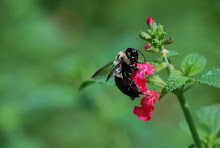Nothing can be more satisfying in your landscape than a bird garden outside the living room or breakfast nook window. The birds' motions and colors, their songs, and the background scenery of foliage and blooms combine into an improvisational bird theater performing just for you.
Situate your bird garden under an existing tree, providing shade, a place to hang feeders, and a landing place for birds to investigate before coming closer. If you don't have a tree, plant one that is already eight to twelve feet tall. It's very important to create several layers of plants to attract birds - a tall tree (oak), a smaller understory tree (dogwood), large shrubs (oakleaf hydrangea), at least one evergreen shrub for winter cover (pieris), small shrubs, perennials and groundcovers. Add spring bulbs there too, so you can enjoy the early blooms while watching the cardinals.
These different levels provide "steps" that the birds can take to the feeder, branches for the species who fly away and roost to break open the seeds, and a place for subordinate birds to wait their turn.
Water is an essential ingredient in your bird garden. You can use a birdbath on a pedestal, on the ground, or build a pond. The water should be clean and cool. Replenish the water in a birdbath daily, especially in the summer months. A fat robin can empty half the water with one lively bath.
For supplemental feeding, include the following three types of feeders:
• A hanging feeder: Birds that feed from hanging feeders include finches, titmice and cardinals. You may want to have more than one hanging feeder, to provide different seed mixtures.
• A suet feeder: A coated wire cage with purchased suet cakes is easy to find by woodpeckers. All suet feeders should be hanging. They may be homemade from onion bags, pine cones, or a hollowed-out log.
• A ground feeder: Juncos, towhees, and quail are some of the birds that feed off of the ground. I use the simplest of ground feeders: the ground. By spreading out the food, there is less competition when several birds try to feed at once. Some bird watchers build a slightly elevated table. You may want to use a shallow pan or a flat stone in your garden. White proso millet and cracked corn are favored by ground feeders.
These three feeders will take care of almost all the birds that come to your garden. If you like, you can add other feeders to your garden, like a hummingbird feeder, or a thistle feeder to attract finches.
What do the Birds do for You?
Besides the entertainment value of the actions, songs, and colors of the birds that come to your garden, they will eat vast quantities of insects. Your garden's best defense against insects is a healthy bird population. Over half of a chickadee's winter diet is comprised of aphid eggs. Some birds also eat rodents and baby snakes, helping to keep these populations in check.
Things to keep in mind:
• Over two million birds a day are killed by raccoons and house cats. Cats are one of the few animals that hunt for the thrill of it - it doesn't matter how much you feed Kitty. Hawks are another feared predator. This creates a puzzle. The shrubs in your bird garden that provide cover and protection from hawks also provide great hiding places for a stalking cat.
• Choose feeders that are easy to clean and clean them regularly with a solution of vinegar and water. Do not use household cleaners or bug repellent on bird feeders. Throw away any moldy feed that could give bacterial infections to the birds.
• Keep chemicals away from your bird garden. The birds are your best method of insect control.
• Use an organic mulch with no black plastic underneath. Pine needles, shredded bark or leaves have a natural look and texture that encourage wildlife. Several birds, including quail, like to scratch around to look for insects and seed. This habit has rarely damaged any of my plants.
• A well-illustrated book can help you identify and learn more about the birds that visit your garden.
A Half Dozen Great Bird Plants:
The best plants for birds offer food and protection for the birds, plus beauty and structure for your garden.
• Blueberry (Vaccinium) – This native provide berries that birds love, plus spring blooms and fall color for your landscape.
• Beautyberry (Callicarpa) – Massing this native plant at a woodland edge provides a thicket for birds, plus a ‘step down’ from tall trees into your landscape. The bright magenta berries are loved by birds and contrast beautifully with the golden fall foliage.
• Dogwood (Cornus florida) – We’re the ones that enjoy the beautiful spring blooms and russet fall color, but the birds appreciate the winter berries and the chance to use this small, native tree to step down from treetops to bird feeders.
• Yaupon holly (Ilex vomitoria) – This evergreen native can reach 10’ or more and is available in a weeping form. The dense, twiggy structure is perfect place for nesting or sheltering from winter winds. The red berries provide food for the birds.
• Junipers (Juniperus) – There are many beautiful and fun varieties of junipers now available, including sculptural small trees. Junipers provide evergreen protection and berries for birds. Other conifers also offer protective cover.
• Viburnums – This large genus includes several with twiggy growth, evergreen foliage and/or berries.
Other plants that attract birds include barberries, crabapple, coneflowers, figs, grapes, grasses, hawthorns, hollies, honeysuckle, mahonias, maples, oaks, pines, pyracantha, roses that produce hips (seed pods), serviceberry, spruces, sumac, sunflowers, and yew
Subscribe to:
Post Comments (Atom)

No comments:
Post a Comment